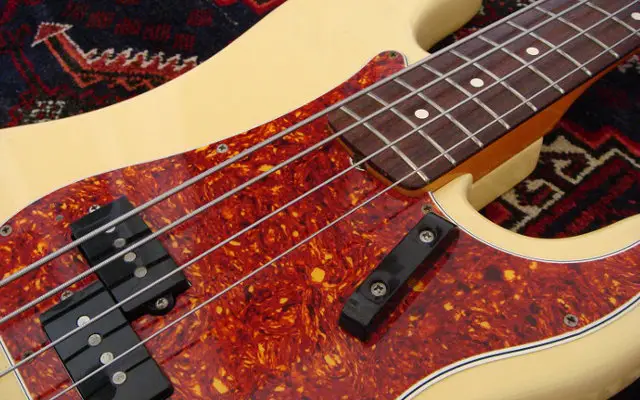In 1982, in an attempt to reclaim their audience’s deep affection that was fostered by the high quality of earlier instruments, Fender introduced their vintage reissue series. These guitars and basses intended to replicate the classic late 50’s to early 60’s instruments of Fender’s Pre-CBS golden era. The Fender Fullerton reissue bass guitars created quite a stir and have since become very collectible in their own right.
The beginning of the downward slide for Fender
By the late 1970s, Fender’s reputation was at an all-time low. Quality control had been waning since CBS bought the company from Leo Fender in 1965. Also, there had been a long slow series of small modifications to Fender’s guitars and basses over the years. This left instruments that weren’t all that similar to their original, and much-beloved designs.
The lack of those original instruments created a major gap in the industry. So, others began to recreate them on their own. In particular, some Japanese companies began to make incredible guitars and basses that would fill the need that modern customers had for that old Fender quality.
Fender makes a bold design move
In an effort to improve their instruments and save the company, Fender hired Bill Schultz to revamp their guitar and bass models.
The first thing Schultz and his team did was to find some vintage Fender instruments and see what made them so great. They studied and scrutinized every detail of these classic axes. Then, they went to work on designing and building the new product line.
It would end up taking tons of time, resources, and money. In fact, Fender basically shut down operations while they retooled their factories in order to make the “new” designs. However, as we now know, it would be worth it.
Recreating a classic Fender bass
The idea behind the vintage reissue series was not to replicate the old basses exactly. It was to build an excellent quality bass that closely resembled those classic instruments and sounded and felt like a vintage Fender bass.
These bass guitars were made using the same tooling as the old ones in the original Fullerton factory in California. They were hand-built as closely as possible to the original specs of the early models. This included the deep-cut body contours, high-quality wood selection, and nitrocellulose lacquer finishes. The team that designed and constructed these instruments later went on to start the famous Fender Custom Shop.
Fender offered three reissue bass models, the ’57 and ’62 Precision Bass and the ’62 Jazz Bass. The main difference between the reissues and the originals is the higher gear ratio on the reissue tuners and the fact that they didn’t have the so-called “clay” position dots like the originals did. The 12th fret position markers were also spaced closer together than they were on the original Fenders. This was apparently a manufacturing hurdle due to tooling and couldn’t be helped. Many of the original custom Fender colors, as well as classic sunburst finishes, were offered on all three models.
The ’62 reissue Jazz Bass featured the stack-knob control setup, which is actually more accurate on a 1960-61 Jazz. The ’57 reissue Precision Bass had the gold anodized aluminum pickguard, raised “A” pole pickup, and one-piece maple neck just like the original bass.
One curious note is that the ’57 reissue featured the “hootenanny” strap button on the back of the headstock. What’s interesting is that this feature didn’t actually appear until 1960.
The New Era of Fender
Fender was sold by CBS to a group of investors, Bill Schultz among them, in 1985. The Fullerton factory was closed, as it was not included in the deal, and Fender relocated to Corona, California. The reissue series continued in 1986 at the Corona location. However, they were no longer using the old tooling machines from Fullerton.
The new reissue basses were now made using CNC machines (computer-controlled). While still excellent basses, they’re not quite the same as the Fullerton models made with the original tooling. Fullerton reissues have slightly slimmer body profiles, deeper contours, and that famous router hump by the neck heel. There are several collectors and players who also feel the pickups sound more vintage correct on the Fullerton models than on the Corona reissues. However, that is debatable.
Fender Fullerton Reissues Today
Fender bass collectors and players alike scour the internet and their local music stores searching for the Fullerton vintage reissue series from 1982-1984. Not only did they create a great line of basses, but they also turned the Fender company around and got them back on track. Producing high-quality instruments again restored Fender’s name and reputation all over the world.
Bill Schultz and his team of builders then went on to create Fender’s Custom Shop division. Here, they created high-quality, accurate relics, and custom hybrids for premium prices. Fender still offers the standard vintage reissue series today. I’ve owned four, and I highly recommend them to anyone seeking a classic Fender vintage feel and tone without breaking the bank on a real pre-CBS Fender bass.

I got Jazz Bass Fullertone. This is an excellent instrument. Invites to play. To get it I traded MusicMan BongoBass 5str. I loved Bongo, but that bass wasn’t for me actually. I hope, the new owner uses it more often than I did.And my Jazz Bass ….honestly, I will never sell it.This is the instrument I have looked for.
Great read and just a fantastic company. Their MIM made instruments are about as good as the MIA ones now. That’s how good Fender has become. I’d go so far as to say some of them are even better than the MIA Am Pro line.